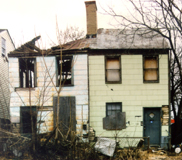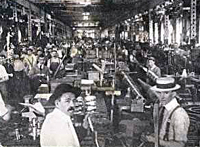VICTORIAN OF THE WEEK #9

C
lick This Thumbnail For A Large, Higher Resolution Image
Click Here to See The Gun Factory Interior Circa 1908
Although any mistakes are undoubtedly mine, Jill Dowling of the Barracks Row MainStreet Project contributed much unique information about these houses. The Barracks Row Project is working to preserve and revitalize 8th Street SE between Pennsylvania Avenue and M Street SE. They have a very informative website at http://www.barracksrow.org
ROWHOUSE REQUIEM
Washington has never been a Detroit, a Pittsburgh, or even an Akron. For 70 years, the largest smokestack in town stood atop the Georgetown streetcar power plant. To see an honest-to-god factory today, you’d have to take a trip to Baltimore.
But as recently as the early 1960s, Washington was home to a world class industrial plant, the Washington Navy Yard. Before World War II, the Navy Yard and Gun Factory was the largest naval ordinance factory in the world, with a workforce that peaked at 25,000. Begining in 1799 it forged everything from ship cannons to anchor chain to precision gunsights, even the gigantic gears that have operated the Panama Canal locks since 1914.
Outside the Yard’s brick walls, which failed to stop local looters during the British invasion in 1812, grew knots of houses for molders, sheet metal workers, machinists, and other heavy metal trades. By the mid-1800s. these clusters of houses had merged into neighborhoods of row and twin houses, two stories tall, with almost no ornament, identical to their immediate neighbors. More humble than their brick neighbors, 1106 and 1108 10th Street SE were among the four houses built by a feed merchant named Samuel Warner on a plot purchased in 1844. There were Warners in at least one of Samuel’s four houses for the next 90 years.
Living within sight of the Navy Yard wall, the Warners could have seen America’s wars play out as a series of neighborhood events. From the corner of M Street, they could have watched the shifts of metal workers rushing to repair the Monitor after her battle with the Merrimac, the Lincoln conspirators being hauled to prison through the Latrobe Gate at 8th and M Streets, or the crowds hurrying down M Street on the morning of July 7, 1865 to watch Mrs. Surratt and companions drop through the traps outside the Old Arsenal Jail. They saw the pulse of the neighborhood quicken again as the Spanish –American War loomed and thousands of Gun Factory workers turned out armament 24 hours per day, 6 days per week. One member of the family, Lawrence, was a Navy Yard machinist from the years that Roosevelt’s Great White Fleet showed America’s might to the world. The family of Herbert Warner, an ice salesman, was still listed at 1106 10th Street SE in the 1930 Census, but had departed by the start of World War II.
After World War II, the Navy Yard carried on with memoranda, manuals, and medals as its major products, but maufacturing operations diminished steadily until ceasing permanently in 1961. Despite their proximity to the Capitol, the old neighborhoods outside the walls continued to deteriorate for decades. When I photographed 1106 and 1108 in November 2001, decay had turned an x-ray on their old bones. Their pastel ceramic shingle siding seemed bizarrely festive, but the broken-out chunks on the front of 1108 exposed paintless original clapboards withered and bleached like the wood in a ghost-town. Fire had flayed the beachfront blue paint off Herbert Warner’s house, skeletized its upper studs and rafters, and left a mound of charred houseguts in the front yard.
I was not aware of the administrative drama playing out around the same time. Although a proposal to expand the Capitol Hill Historic District to M Street SE was successful, Square 796, which contains these houses, was excluded, apparently because it included too few intact vintage buildings. A later plan to landmark 1106 and 1108 as two of approximately twenty Civil War era buildings in the neighborhood did not come to pass.
I was saddened when not surprised when 1106 and 1108 became an empty lot covered with small stones this spring. Ironically, the recent relocation of many federal workers to the Navy Yard is the engine driving redevelopment of much of the land in the M and South Capitol Street corridors. In the past 18 months, dozens of similar rowhouses have vanished. Few were rchitecturally ornate or individually notable, but taken collectively they were at the heart of Washington.
